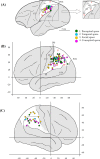The posterior parietal cortex and non-spatial cognition
- PMID: 20948614
- PMCID: PMC2948259
- DOI: 10.3410/B1-74
The posterior parietal cortex and non-spatial cognition
Abstract
The primate posterior parietal cortex (PPC) processes information related to environmental physical space. The human PPC has apparently expanded not only in size but also in its functional range to encompass certain abstract and higher-order conceptual spaces. In this report, we review various forms of non-spatial representation in the PPC. These forms are presented roughly in order of the level of abstraction of the 'objects' and pseudo-spatial relations represented. Also, we consider mechanisms that could have enabled the hominid PPC to establish such representations. Lastly, we offer a general principle to unify the newer forms of representation with the original functions of the PPC.
Figures


Similar articles
-
The history of the neurophysiology and neurology of the parietal lobe.Handb Clin Neurol. 2018;151:3-30. doi: 10.1016/B978-0-444-63622-5.00001-2. Handb Clin Neurol. 2018. PMID: 29519464 Review.
-
Meta-analysis: how does posterior parietal cortex contribute to reasoning?Front Hum Neurosci. 2015 Jan 21;8:1042. doi: 10.3389/fnhum.2014.01042. eCollection 2014. Front Hum Neurosci. 2015. PMID: 25653604 Free PMC article.
-
The Posterior Parietal Cortex in Adaptive Visual Processing.Trends Neurosci. 2018 Nov;41(11):806-822. doi: 10.1016/j.tins.2018.07.012. Epub 2018 Aug 14. Trends Neurosci. 2018. PMID: 30115412 Free PMC article. Review.
-
A brief comparative review of primate posterior parietal cortex: A novel hypothesis on the human toolmaker.Neuropsychologia. 2017 Oct;105:123-134. doi: 10.1016/j.neuropsychologia.2017.01.034. Epub 2017 Jan 31. Neuropsychologia. 2017. PMID: 28159617 Free PMC article. Review.
-
Mixed Spatial and Movement Representations in the Primate Posterior Parietal Cortex.Front Neural Circuits. 2019 Mar 11;13:15. doi: 10.3389/fncir.2019.00015. eCollection 2019. Front Neural Circuits. 2019. PMID: 30914925 Free PMC article. Review.
Cited by
-
Linguistic asymmetry, egocentric anchoring, and sensory modality as factors for the observed association between time and space perception.Cogn Process. 2017 Nov;18(4):479-490. doi: 10.1007/s10339-017-0817-6. Epub 2017 May 17. Cogn Process. 2017. PMID: 28516394
-
Triadic (ecological, neural, cognitive) niche construction: a scenario of human brain evolution extrapolating tool use and language from the control of reaching actions.Philos Trans R Soc Lond B Biol Sci. 2012 Jan 12;367(1585):10-23. doi: 10.1098/rstb.2011.0190. Philos Trans R Soc Lond B Biol Sci. 2012. PMID: 22106423 Free PMC article. Review.
-
Stochastic Dynamics Underlying Cognitive Stability and Flexibility.PLoS Comput Biol. 2015 Jun 12;11(6):e1004331. doi: 10.1371/journal.pcbi.1004331. eCollection 2015 Jun. PLoS Comput Biol. 2015. PMID: 26068119 Free PMC article.
-
Old cortex, new contexts: re-purposing spatial perception for social cognition.Front Hum Neurosci. 2013 Oct 8;7:645. doi: 10.3389/fnhum.2013.00645. eCollection 2013. Front Hum Neurosci. 2013. PMID: 24115928 Free PMC article.
-
Repetitive transcranial magnetic stimulation over the posterior parietal cortex improves functional recovery in nonresponsive patients: A crossover, randomized, double-blind, sham-controlled study.Front Neurol. 2023 Feb 16;14:1059789. doi: 10.3389/fneur.2023.1059789. eCollection 2023. Front Neurol. 2023. PMID: 36873436 Free PMC article.
References
-
- Hadamard J. Mieola NY: Dover Publications; 1954. The Psychology of Invention in the Mathematical Field.
-
- Duhamel JR, Colby CL, Goldberg ME. Congruent representation of visual and somatosensory space in single neurons of monkey ventral intraparietal cortex area (area VIP) In: Paillard J, editor. Brain and Space. Oxford: Oxford University Press; 1991. pp. 223–36.
-
- Brodmann K. Ihren Prinzipien dargestellt auf Grund des Zellenbaues. Leipzig: Johann Ambrosius Barth; 1909. Localisation in the cerebral cortex.

